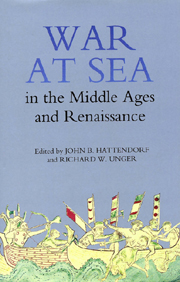Book contents
- Frontmatter
- Contents
- List of illustrations
- List of Contributors
- Preface
- Acknowledgements
- Introduction: Theories of Naval Power: A. T. Mahan and the Naval History of Medieval and Renaissance Europe
- I Northern Europe
- II Southern Europe
- Byzantium and the Sea: Byzantine Fleets and the History of the Empire in the Age of the Macedonian Emperors, c.900–1025 CE
- Iberian Naval Power, 1000–1650
- Venice, Genoa and Control of the Seas in the Thirteenth and Fourteenth Centuries
- Genoese Naval Forces in the Mediterranean during the Fifteenth and Sixteenth Centuries
- An Exemplary Maritime Republic: Venice at the End of the Middle Ages
- III Sixteenth and Early-Seventeenth-Century Europe
- Conclusion: Toward a History of Medieval Sea Power
- Index
- Titles in the series
Byzantium and the Sea: Byzantine Fleets and the History of the Empire in the Age of the Macedonian Emperors, c.900–1025 CE
from II - Southern Europe
Published online by Cambridge University Press: 05 April 2013
- Frontmatter
- Contents
- List of illustrations
- List of Contributors
- Preface
- Acknowledgements
- Introduction: Theories of Naval Power: A. T. Mahan and the Naval History of Medieval and Renaissance Europe
- I Northern Europe
- II Southern Europe
- Byzantium and the Sea: Byzantine Fleets and the History of the Empire in the Age of the Macedonian Emperors, c.900–1025 CE
- Iberian Naval Power, 1000–1650
- Venice, Genoa and Control of the Seas in the Thirteenth and Fourteenth Centuries
- Genoese Naval Forces in the Mediterranean during the Fifteenth and Sixteenth Centuries
- An Exemplary Maritime Republic: Venice at the End of the Middle Ages
- III Sixteenth and Early-Seventeenth-Century Europe
- Conclusion: Toward a History of Medieval Sea Power
- Index
- Titles in the series
Summary
WHEN Basil I (867–86), the founder of the ‘Macedonian’ dynasty, seized the throne, the Byzantine Empire was at one of its recurrent nadirs. Crete had fallen to Spanish Muslims around 824. Effective authority over Cyprus and Rhodes had been lost much earlier. Cilicia was in the hands of Muslim corsair emirs. In the North, the Empire was under pressure from the Patzinaks, Magyars, and Bulgars. In the West, Byzantine presence in south Italy was ephemeral.
By the death of Basil II (976–1025) it all looked very different. The maritime approaches to the Empire from the south and west had been secured by the re-establishment of firm rule in south Italy during the reign of Basil I and by the reconquest of Crete in 960–1, Cyprus in 965, Rhodes at some unknown date, and Cilicia and northern Syria in the second half of the tenth century. Basil II destroyed the First Bulgarian Empire in 1018 and pushed the northern frontier back to the Danube, where it remained in spite of occasional Patzinak pressure.
In all of this, Byzantine fleets played operational roles at various times. By the Macedonian era, these consisted of an ‘imperial’ fleet based on Constantinople commanded by the δϱουγγάϱιος τοῦ πλίμου (droungarios tou ploimou), ‘admiral of the fleet’, and the thematic fleets of the Kibyrrhaiōtai based at Attaleia, the northern Aegean (theme of Aigaion Pelagos, Aegean Sea), and the southern Aegean (theme of Samos, based at Samos), each under their στϱατηγοί (stratēgoi), generals/admirals.
- Type
- Chapter
- Information
- War at Sea in the Middle Ages and the Renaissance , pp. 83 - 104Publisher: Boydell & BrewerPrint publication year: 2002



